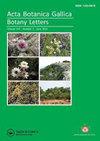Ten years of citizen science data collection of wetland plants in an urban protected area
引用次数: 6
Abstract
Abstract Floodplain landscape is the result of man’s presence over a long period of time. This has caused the degradation, or even loss, of several habitats, especially wetlands, which frequently preserve rare biodiversity, even though they are subjected to intense human presence. Human activities can be of value, but can also cause problems in species preservation. The protected area “Ansa e Valli del Mincio” (northern Italy) is an outstanding case study in this respect: it is located in a densely urbanized context, but has great value from a conservation standpoint. This paper presents the results of 10 years of monitoring (2003–2012) of the spatial distribution of two native species (Trapa natans and Nymphaea alba) and the invasive Nelumbo nucifera. Data collected by volunteers from the protected area were processed in GIS and analysed using a number of configurational landscape metrics. Nymphaea alba and N. nucifera became more widespread; T. natans underwent a serious decline, mostly due to the interference of N. nucifera. An oscillating trend of this species is visible until 2008, followed by substantial stability. Furthermore, the potential area of each species was calculated. On the whole, citizen science is a valuable tool to enhance biodiversity knowledge and safeguarding, especially in wetlands that are used for tourism and surrounded by residential areas. As in other contexts, the volunteer contribution was particularly helpful in data collection on a local scale, over a considerable time span.城市保护区湿地植物十年公民科学数据收集
漫滩景观是人类长期存在的结果。这造成了若干生境的退化,甚至丧失,特别是湿地,这些生境虽然受到强烈的人类活动的影响,但往往保存着稀有的生物多样性。人类活动可能是有价值的,但也可能在物种保护方面造成问题。“Ansa e Valli del Mincio”保护区(意大利北部)在这方面是一个杰出的案例研究:它位于密集的城市化环境中,但从保护的角度来看具有很大的价值。本文介绍了2003-2012年10年对两种本地物种(山竹、白花花)和外来入侵物种蓝莲花(Nelumbo nucifera)空间分布的监测结果。志愿者从保护区收集的数据在GIS中进行处理,并使用一些配置景观指标进行分析。白睡莲和金针花分布更广;赤霉病发生了严重的衰退,主要是由于黑桫椤的干扰。在2008年之前,这一物种的波动趋势是可见的,随后是实质性的稳定。此外,还计算了各树种的潜在面积。总体而言,公民科学是提高生物多样性知识和保护的宝贵工具,特别是在用于旅游和被居民区包围的湿地。与其他情况一样,志愿人员的贡献在相当长的一段时间内特别有助于在地方范围内收集数据。
本文章由计算机程序翻译,如有差异,请以英文原文为准。
求助全文
约1分钟内获得全文
求助全文

 求助内容:
求助内容: 应助结果提醒方式:
应助结果提醒方式:


